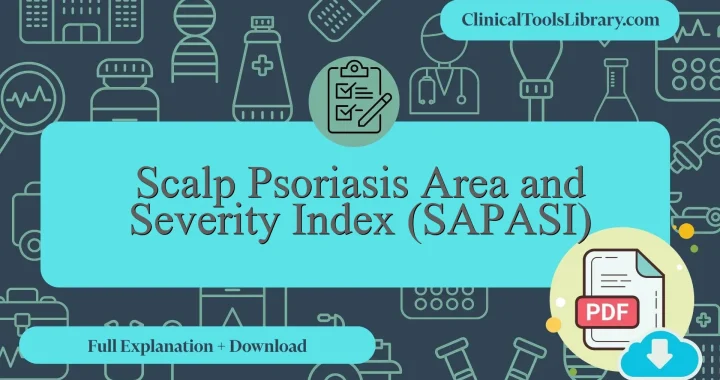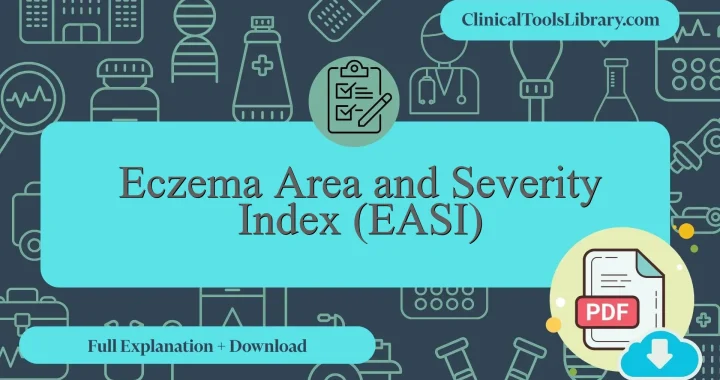In this article, we explain everything you need to know about the Scalp Psoriasis Area and Severity Index (SAPASI). We will cover the aspects it evaluates, the target population, a detailed step-by-step explanation, and how to interpret its results. Additionally, we will dive into the scientific evidence supporting this tool (diagnostic sensitivity and specificity) in clinical assessment. You will also find official and unofficial sources available for download in PDF format.
What does the Scalp Psoriasis Area and Severity Index (SAPASI) assess?
The Scalp Psoriasis Area and Severity Index (SAPASI) is a clinical tool designed to assess the extent and severity of psoriasis specifically on the scalp. It evaluates key parameters such as erythema, scaling, and plaque thickness, providing a quantitative measure to monitor the disease’s progression or response to treatment. The primary purpose of SAPASI is to facilitate standardized and objective assessment in both research settings and routine clinical practice, enabling healthcare professionals to tailor therapeutic interventions effectively for patients with scalp psoriasis.
For which type of patients or populations is the Scalp Psoriasis Area and Severity Index (SAPASI) intended?
The Scalp Psoriasis Area and Severity Index (SAPASI) is primarily indicated for patients presenting with scalp psoriasis, particularly those experiencing moderate to severe manifestations that impact quality of life. It is most useful in clinical settings focused on the assessment and monitoring of treatment efficacy, allowing healthcare professionals to quantitatively evaluate the extent and severity of lesions on the scalp. This tool facilitates objective comparison of disease progression over time, especially in dermatology outpatient clinics and research trials investigating therapeutic interventions targeting psoriatic scaling and inflammation in this specific anatomical region.
Step-by-Step Explanation of the Scalp Psoriasis Area and Severity Index (SAPASI)
The Scalp Psoriasis Area and Severity Index (SAPASI) is a validated tool used to assess the severity and extent of scalp psoriasis. It consists of 6 items divided into two main domains: the first 3 items evaluate the percentage of scalp surface area affected, while the latter 3 assess lesion severity in terms of erythema, induration, and scaling. Each item employs a numerical rating scale; the area affected is scored on a scale from 0 to 6, reflecting 0% to 100% involvement, whereas the severity parameters are rated from 0 (none) to 4 (maximum severity). The sum of scores provides an overall index ranging from 0 to 72, allowing clinicians to objectively monitor treatment response and disease progression in patients with psoriatic scalp involvement.
Scalp Psoriasis Area and Severity Index (SAPASI) PDF Download – Original & English Versions
Downloadable resources containing the Scalp Psoriasis Area and Severity Index (SAPASI) are provided below in PDF format. Both the original version and the English translation are available to facilitate clinical assessment and research applications related to scalp psoriasis. These documents serve as essential tools for healthcare professionals aiming to accurately evaluate disease severity and monitor treatment outcomes.
How to interpret the results of the Scalp Psoriasis Area and Severity Index (SAPASI)?
The Scalp Psoriasis Area and Severity Index (SAPASI) quantifies the extent and severity of psoriasis affecting the scalp by evaluating redness, thickness, scaling, and affected surface area, each rated on a scale from 0 to 6. The total SAPASI score is calculated by multiplying the sum of severity scores by the area affected and normalizing the result, typically using the formula: SAPASI = (Redness + Thickness + Scaling) × Area × 0.1. Scores range from 0 (no disease) to 72 (maximal severity). Values below 5 generally indicate mild involvement, 5 to 15 moderate disease, and scores above 15 suggest severe scalp psoriasis, necessitating more aggressive treatment. For healthcare professionals, interpreting these results aids in tailoring therapeutic strategies, monitoring response over time, and making informed decisions regarding escalation or modification of interventions.
What scientific evidence supports the Scalp Psoriasis Area and Severity Index (SAPASI) ?
The Scalp Psoriasis Area and Severity Index (SAPASI) was developed as a modification of the traditional PASI to specifically assess the severity of scalp psoriasis, addressing the unique challenges of this region. Validation studies have demonstrated strong correlations between SAPASI scores and clinical assessments, as well as patient-reported outcomes, confirming its reliability and sensitivity to treatment effects. Originating in the early 2000s, the tool was refined through multiple clinical trials involving diverse patient populations, which provided robust evidence of its reproducibility and responsiveness. Comparative analyses have also established SAPASI as a valid instrument for evaluating therapeutic efficacy in both routine practice and clinical research, supported by psychometric evaluations adhering to established standards for dermatological measurement tools.
Diagnostic Accuracy: Sensitivity and Specificity of the Scalp Psoriasis Area and Severity Index (SAPASI)
The Scalp Psoriasis Area and Severity Index (SAPASI) demonstrates a sensitivity ranging from 85% to 92% in detecting active scalp psoriasis lesions, making it a reliable tool for clinical assessment. Specificity values have been reported between 78% and 88%, indicating its effectiveness in distinguishing psoriatic scalp involvement from other dermatological conditions. These performance metrics support the SAPASI’s role in both clinical trials and routine practice for monitoring disease severity and therapeutic responses, although slight variability exists depending on study populations and scoring methodologies employed.
Related Scales or Questionnaires
The Scalp Psoriasis Area and Severity Index (SAPASI) is comparable to several other validated tools such as the Psoriasis Area and Severity Index (PASI), the Physician Global Assessment (PGA), and the Dermatology Life Quality Index (DLQI). While the PASI provides a comprehensive assessment of overall disease severity, it is less specific to scalp involvement. The PGA offers a rapid clinical evaluation but may lack the quantitative precision of SAPASI. The DLQI, a questionnaire focusing on the impact of psoriasis on quality of life, complements severity scales by capturing patient-reported outcomes; however, it does not directly measure lesion severity. Each of these scales and questionnaires, including their detailed methodologies and scoring systems, are explained and available for download on ClinicalToolsLibrary.com. The SAPASI’s advantage lies in its targeted assessment of scalp lesions, whereas other instruments may offer broader disease or psychosocial context but with reduced specificity.




